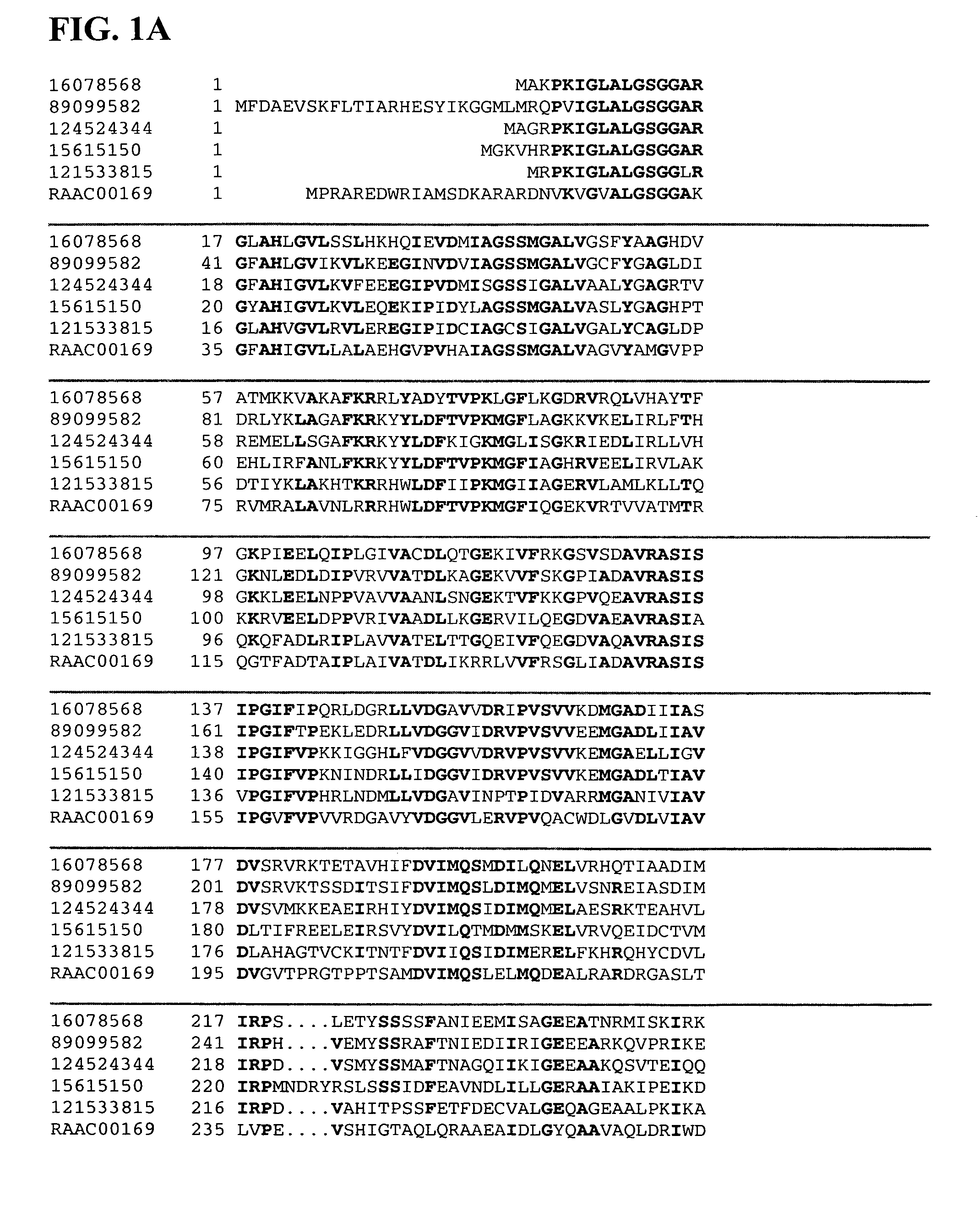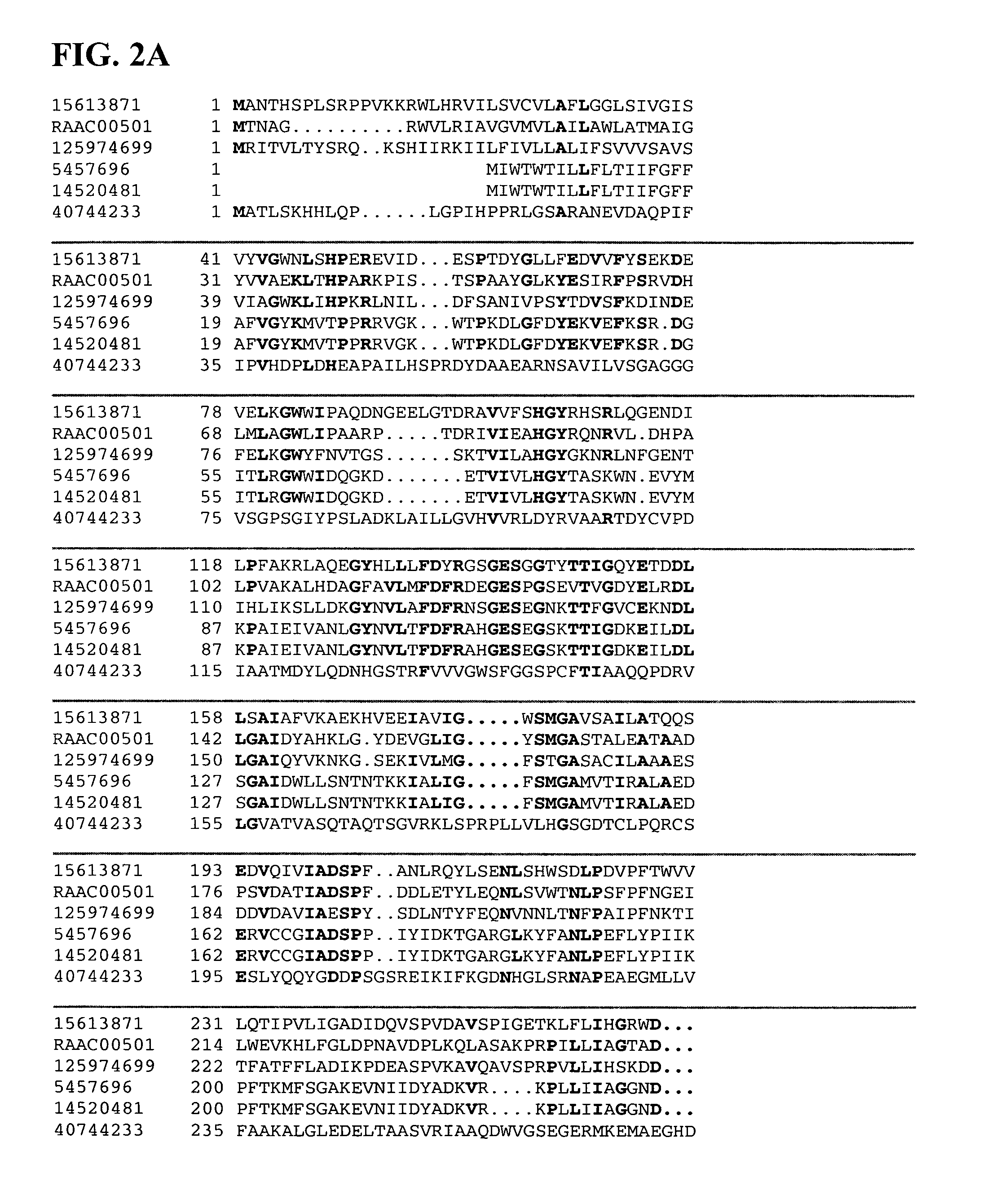Thermophilic and thermoacidophilic biopolymer-degrading genes and enzymes from Alicyclobacillus acidocaldarius and related organisms, methods
- Summary
- Abstract
- Description
- Claims
- Application Information
AI Technical Summary
Benefits of technology
Problems solved by technology
Method used
Image
Examples
example 1
RAAC00169: an Esterase of the Alpha-Beta Hydrolase Superfamily
[0185]Provided in SEQ ID NO:1 is a nucleotide sequence isolated from Alicyclobacillus acidocaldarius and encoding the polypeptide of SEQ ID NO:2. As can be seen in FIGS. 1A and 1B, SEQ ID NO:2 aligns well with other proteins identified as esterases of the alpha-beta hydrolase superfamily. Of particular importance, it is noted that where amino acids are conserved in other esterases of the alpha-beta hydrolase superfamily, those amino acids are generally conserved in SEQ ID NO:2. Thus, the polypeptide provided in SEQ ID NO:2 is properly classified as an esterase of the alpha-beta hydrolase superfamily.
[0186]The polypeptides of SEQ ID NOs:13-17 are representative examples of conservative substitutions in the polypeptide of SEQ ID NO:2 and are encoded by nucleotide sequences of SEQ ID NOs:8-12, respectively.
[0187]The nucleotide sequences of SEQ ID NOs:1 and 8-12 are placed into expression vectors using techniques standard in ...
example 2
RAAC00501: an Alpha-Beta Hydrolase
[0189]Provided in SEQ ID NO:18 is a nucleotide sequence isolated from Alicyclobacillus acidocaldarius and encoding the polypeptide of SEQ ID NO:19. As can be seen in FIGS. 2A and 2B, SEQ ID NO:19 aligns well with other proteins identified as alpha-beta hydrolases. Of particular importance, it is noted that where amino acids are conserved in other alpha-beta hydrolases, those amino acids are generally conserved in SEQ ID NO:19. Thus, the polypeptide provided in SEQ ID NO:19 is properly classified as an alpha-beta hydrolase.
[0190]The polypeptides of SEQ ID NOs:30-34 are representative examples of conservative substitutions in the polypeptide of SEQ ID NO:19 and are encoded by the nucleotide sequences of SEQ ID NOs:25-29, respectively.
[0191]The nucleotide sequences of SEQ ID NOs:18 and 25-29 are placed into expression vectors using techniques standard in the art. The vectors are then provided to cells such as bacteria cells or eukaryotic cells such as ...
example 3
RAAC00568: an Alpha-Glucosidase
[0193]Provided in SEQ ID NO:35 is a nucleotide sequence isolated from Alicyclobacillus acidocaldarius and encoding the polypeptide of SEQ ID NO:36. As can be seen in FIGS. 3A, 3B, and 3C, SEQ ID NO:36 aligns well with other proteins identified as alpha-glucosidases. Of particular importance, it is noted that where amino acids are conserved in other alpha-glucosidases, those amino acids are generally conserved in SEQ ID NO:36. Thus, the polypeptide provided in SEQ ID NO:36 is properly classified as an alpha-glucosidase.
[0194]The polypeptides of SEQ ID NOs:46-50 are representative examples of conservative substitutions in the polypeptide of SEQ ID NO:36 and are encoded by nucleotide sequences of SEQ ID NOs:41-45, respectively.
[0195]The nucleotide sequences of SEQ ID NOs:35 and 41-45 are placed into expression vectors using techniques standard in the art. The vectors are then provided to cells such as bacteria cells or eukaryotic cells such as Sf9 cells o...
PUM
| Property | Measurement | Unit |
|---|---|---|
| temperature | aaaaa | aaaaa |
| pH | aaaaa | aaaaa |
| temperatures | aaaaa | aaaaa |
Abstract
Description
Claims
Application Information
 Login to View More
Login to View More - R&D
- Intellectual Property
- Life Sciences
- Materials
- Tech Scout
- Unparalleled Data Quality
- Higher Quality Content
- 60% Fewer Hallucinations
Browse by: Latest US Patents, China's latest patents, Technical Efficacy Thesaurus, Application Domain, Technology Topic, Popular Technical Reports.
© 2025 PatSnap. All rights reserved.Legal|Privacy policy|Modern Slavery Act Transparency Statement|Sitemap|About US| Contact US: help@patsnap.com



